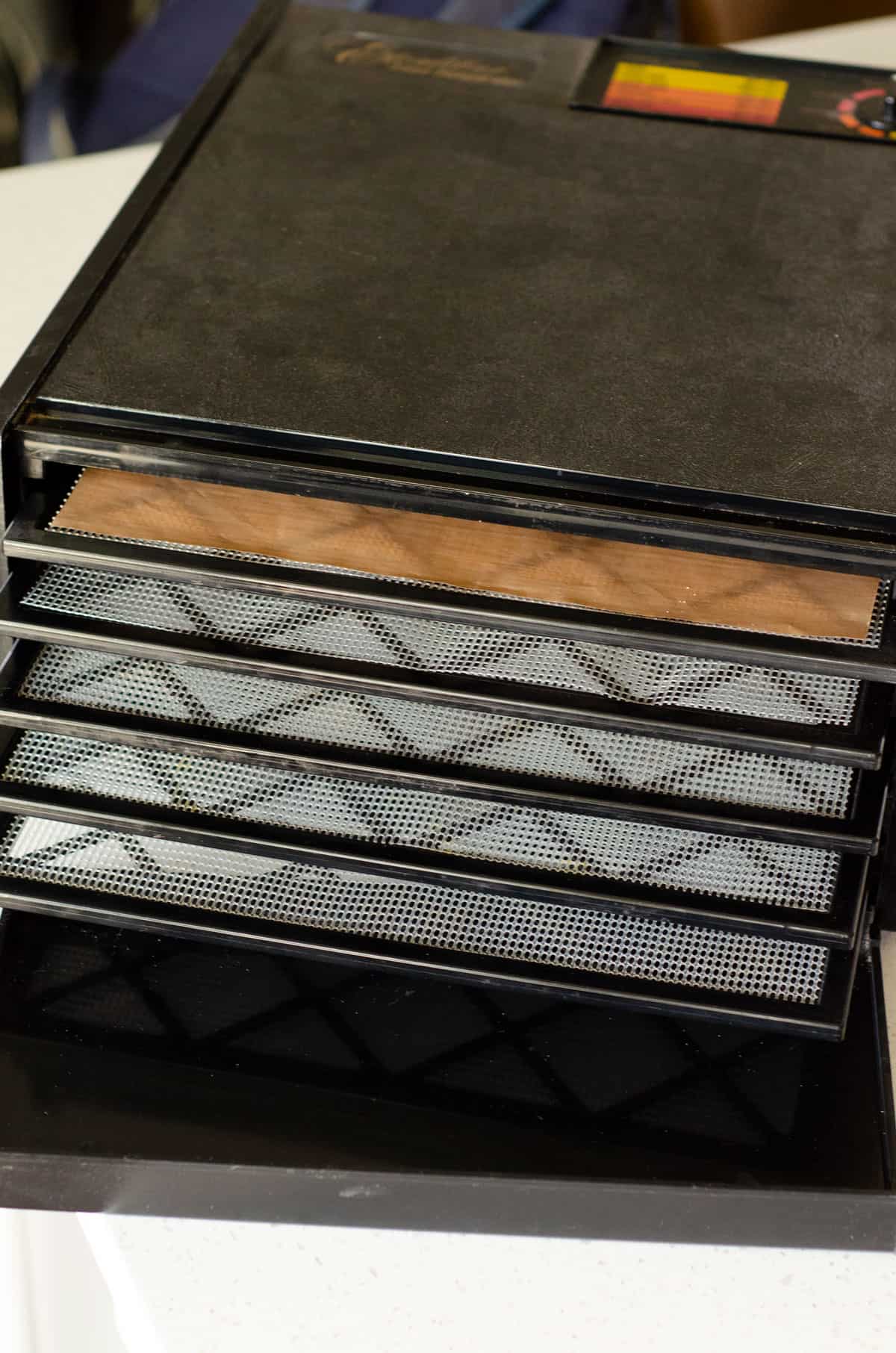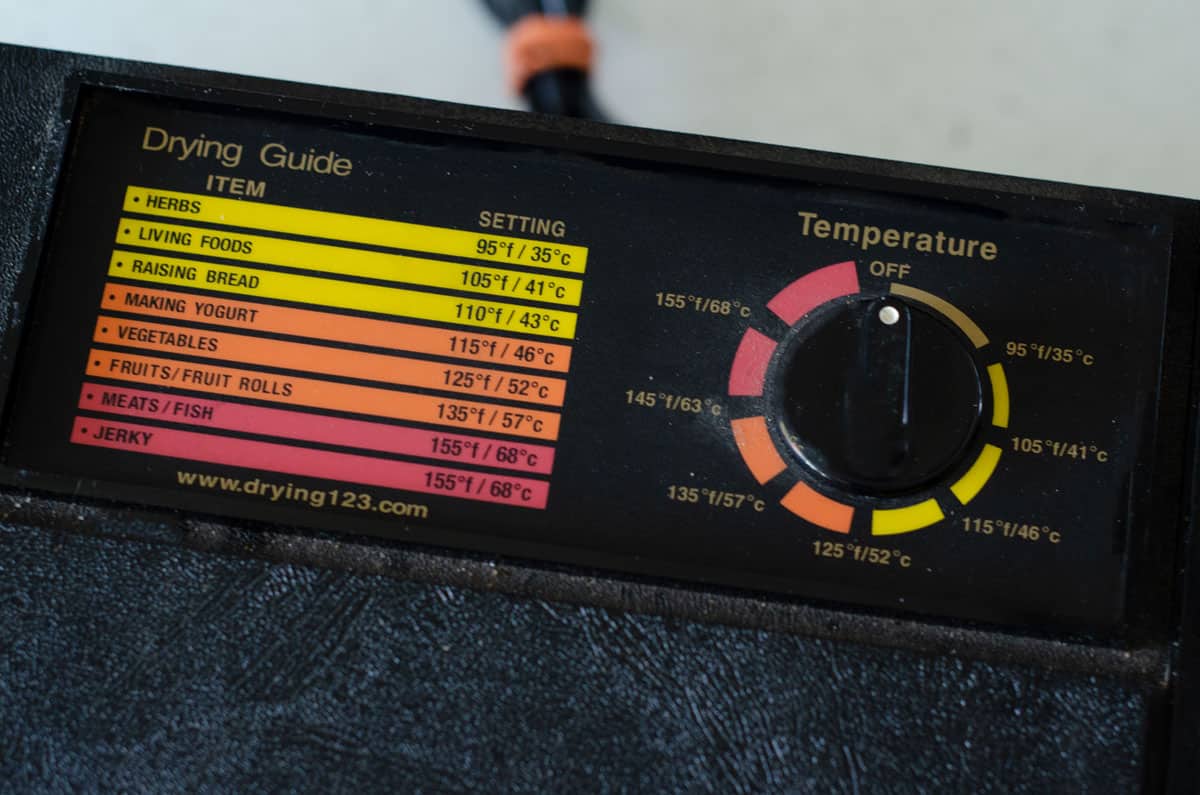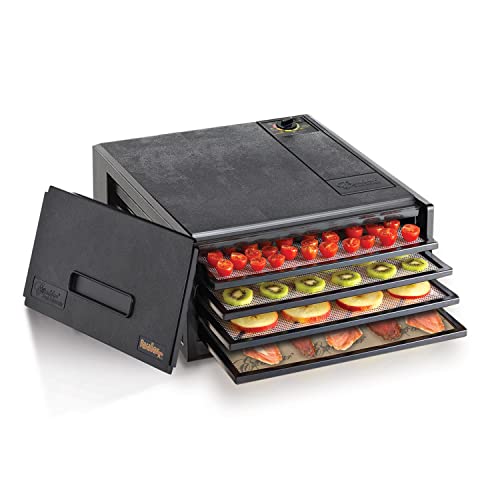This teriyaki venison jerky recipe uses venison strips marinated in a homemade teriyaki sauce. Packed full of flavor, these deer meat strips make a perfect high protein snack.

One of the most popular recipes on this blog is my homemade beef jerky recipe. And while beef is a more readily available meat, venison makes a great jerky due to the leanness of the meat. Not having much fat on it makes it great for dehydrating.
A few years ago, Brandan started hunting. While it's less about the hunting for him and more about the time in nature, it's always nice when food for our family is also the end result.
The first time he shot a deer, he brought it home and we processed it ourselves in our kitchen at 11pm while Slater slept. Needless to say, this year, when he landed a buck, I told him to take it straight to the processor.
Most of the venison came out as ground, with a few roasts as well. We decided to try our hand at a teriyaki venison jerky recipe with a roast. My teriyaki sauce recipe is a solid one, so I whipped up a batch and we put them together to marinate.
Venison is a very lean meat - it does not have a high fat content, so it will dry quicker than red meat will. For this jerky recipe, we simply cut meat slices into strips of jerky.
Some people like to take ground meat and use a tool called a jerky gun to squeeze out jerky. This reminds me of "reconstituted meat products" similar to a hot dog, so my preference is just to go ahead and slice a cut against the grain into thin strips.
If you're still on the fence about venison, don't be! I was a skeptic at first, but it's really actually delicious when prepared correctly, is good for you, and it has a number of health benefits.
Recipe prep
We started with about 3 pounds of meat. For this particular wild game jerky, we used a venison leg roast, but there are many cuts of venison roasts that you can use.
Slice it to the thickness of your liking - thick strips will result in a chewier jerky; thin strips will result in a less chewy jerky. We put it in the teriyaki marinade in a plastic bag in the fridge and left it for a few days. I would recommend at least 12-24 hours to get it fully marinated, but you're not going to hurt it leaving it up to 72-96 hours!
The teriyaki marinade is simply my teriyaki sauce recipe, minus the tapioca starch and the cooking down to thicken. You'll just combine all the marinade ingredients in a large bowl, mix them up, and that's it!
Many other jerky recipes marinate ingredients include things like brown sugar, liquid smoke, garlic powder, worcestershire sauce, black pepper, and onion powder. You'll also see recipes that call for Prague powder, or pink curing salt.
This pink salt is commonly used in commercially made jerky as a preservative or curing agent, and contains sodium nitrate as well as sodium nitrite. These are ingredients that we try to avoid, so we don't use them. You can use celery salt as an alternative to pink curing salt if you're concerned about the length of preservation.
Put the strips into a large plastic bag with the marinade and stick it in the fridge. It needs at least 4-5 hours; overnight or for a day or two is even better. When you're ready to make your deer jerky, take your venison slices out of the marinade and discard the extra marinade. Your next steps will be similar but slightly different based on whether you're using a dehydrator or an oven.
Dehydrator instructions
The easiest way to make homemade jerky is to use a food dehydrator. There are a number of options out there for this. We have the "Cadillac"of food dehydrators, the Paralexx Excalibur. It's a tray dehydrator. We have the 5 tray, which appears to be discontinued, but they do still offer a 4 tray and a 9(!) tray option.

When making jerky in it, you'll use the dehydrator trays with the plastic mesh inserts. It comes with some sheets as well, but you don't want to use those for this. They are great for making things like fruit leather. When you're making jerky strips in the dehydrator, you want the air to be able to circulate all the way around the meat.

Take out the marinated meat and lay the strips out in a single layer on the trays. If you choose to, you can sprinkle with sesame seeds while the marinade is still wet. Once it dries, the seeds will no longer stick. (We skipped that this time, not for any particular reason, we just forgot!)

You'll turn it up to the highest setting at 155°, which is indicated as jerky:

From there, close it up and let it run. Cooking times will vary depending on how thick you cut it and how much meat you're using. It might take a long time, so be patient! Check it every so often to see if it's dried to your liking. If not, run it a bit longer.
Once it's dried, turn off the dehyrator and open the front. Let it cool before removing it from the trays.

Oven instructions
The drying process in the oven is a little bit different. You'll want the oven rack to be right in the middle, and you'll want to put wire racks on baking sheets to achieve the best results of getting the meat fully dehydrated.
I live and die by these Nordicware half sheets, and a wire cookie rack fits right inside perfectly.
Make sure your oven is on low heat or the 'keep warm' setting - depending on the oven, your lowest temperature might be 170°, which is fine.

The process will be the same as outlined in my beef jerky post - keep it on the lowest setting, let it run for a few hours. Beef goes for about 6 hours, give or take. Check it before then for doneness - venison may dehydrate a bit quicker due to the lower fat content, so make sure not to overdo it!
Storage
Your jerky has to be completely dry before storing. If there's still any moisture left in the meat, when you close it up in an airtight container, it will grow mold. In my experience, the shelf life of the jerky depends on how thick you cut it (thin strips will stay good for longer.)
I tend to store ours in the fridge. This does make it a bit tougher to eat unless you let it come to room temperature, but it preserves it for longer.
My husband has a tendency to cut the strips somewhat thick, as he likes his jerky a little bit chewy. Because of this, it can spoil more quickly, as it still has some moisture left in it. Adding paper towels inside the bag of dried meat can help with the moisture level as well.
Recipe Notes
- There is no need to include the tapioca starch in the teriyaki sauce recipe. That is there to help it thicken when cooked down when using the sauce not as a marinade. For our purposes, we are just marinating, and it can remain thin.
- Cook time will depend on how thin the meat was cut. Thinner strips will dehydrate faster, so check accordingly.
- The finished product will last longer in the fridge, since no curing salts are used. Allow to come to room temp before eating, otherwise it will be tough!
- Add a paper towel in the storage container to absorb any excess moisture and extend the life of your jerky.
Recipe

Teriyaki Venison Jerky Recipe
This teriyaki venison jerky recipe is the perfect simple and tasty high protein snack! Perfect for backpacking, being on-the-go, or an anytime quick fix meat snack.
Ingredients
- 3 lb venison leg roast
- 1 batch teriyaki sauce
Instructions
- Combine all teriyaki sauce ingredients except tapioca starch and whisk to combine. Do not heat up or cook!
- Slice venison roast into strips of preferred thickness.
- Add venison strips and sauce to a large ziplock bag and seal. Place in the fridge for a day or two to marinate.
- Lay out the strips on your dehydrator shelves or on a wire rack placed on a baking sheet. Make sure to leave enough space for air to circulate around all the pieces.
- Place in dehydrator on jerky setting or oven on 170°/keep warm for 5-6 hours or until meat is dry and no moisture remains.
- Allow to cool, then store in a clean ziplock bag or tupperware.
Notes
Cook time will depend on how thin the meat was cut. Thinner strips will dehydrate faster, so check accordingly.
The finished product will last longer in the fridge, since no curing salts are used. Allow to come to room temp before eating, otherwise it will be tough!
Add a paper towel in the storage container to absorb any excess moisture and extend the life of your jerky.
Recommended Products
As an Amazon Associate and member of other affiliate programs, I earn from qualifying purchases, at no additional cost to you. Thank you for your support!
Nutrition Information:
Yield: 10 Serving Size: 1Amount Per Serving: Calories: 206Total Fat: 3gSaturated Fat: 2gTrans Fat: 0gUnsaturated Fat: 1gCholesterol: 108mgSodium: 147mgCarbohydrates: 0gFiber: 0gSugar: 0gProtein: 41g
I may earn a small commission off purchases made through affiliate links in this post from Amazon and other sellers. This helps me continue to run the blog and keep providing you fresh content. Thank you for your support!






Leave a Reply